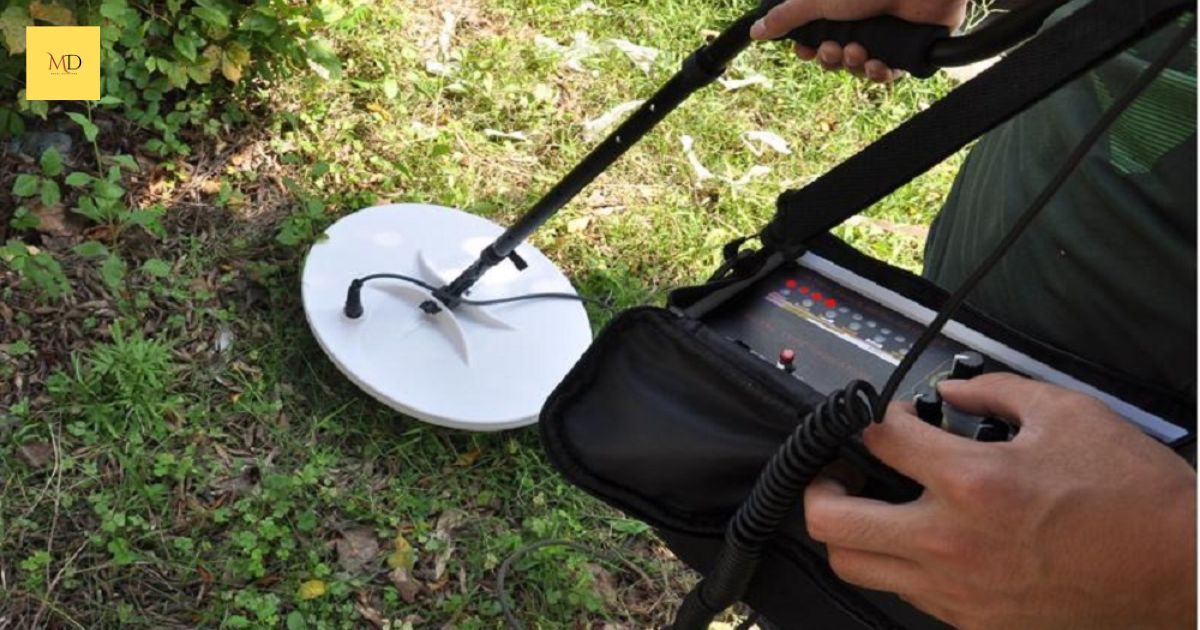Metal detectors are electronic devices that detect the presence of metal objects. They work by generating a magnetic field and analyzing changes in the field when metal is nearby. Metal detectors are commonly used for security purposes to locate weapons or contraband, and they are also employed in hobbies like treasure hunting and archaeology.
Do Metal Detectors Detect Vapes? If you’ve ever wondered whether those beeping security scanners at the airport could uncover something as discreet as a vape pen, you’re not alone. The answer might surprise you, so read on to find out, and consider the implications for your next journey through airport security or any other place where metal detectors are in use.
Metal detectors can detect vapes that contain metal components. Many vapes have metal parts, like the heating element or batteries, which can trigger alarms in metal detectors, particularly in security settings like airports or public buildings. However, small vape pens with minimal metal content may not always set off alarms, and it depends on the sensitivity of the metal detector.
How Metal Detectors Work
Metal detectors operate on a straightforward yet effective principle. They generate a magnetic field through a coil of wire, which, when powered, creates a magnetic field around the coil. When this magnetic field encounters a metal object, it disrupts the electromagnetic field, producing an electromagnetic response in the metal. This response induces a small electric current in the metal, which, in turn, creates a secondary magnetic field.
The detector’s electronics analyze the signal from the receiver coil and can differentiate between different types of metals based on the time it takes for the disrupted field to return to its original state. In essence, the time delay in the signal helps the metal detector identify the type of metal and the presence of metal in the scanned area. By adjusting the sensitivity levels, operators can determine what size and type of metal objects the detector will react to, making them versatile tools for various applications, from treasure hunting to security screenings.
Principles of Metal Detection
The principles of metal detection involve the use of electromagnetic fields to identify and locate metallic objects. When a metal detector is turned on, it generates an electromagnetic field around its coil or search head. This field interacts with any nearby metal objects, causing a disruption in the field. When the disruption occurs, the metal detector’s circuitry registers a change, which is then signaled to the user through visual or auditory alerts.
These principles are based on the fact that metals conduct electricity and magnetism differently than non-metallic materials. Metal detectors exploit this difference in conductivity to distinguish between metal and non-metal objects. By measuring the degree of disruption in the electromagnetic field and the time it takes for the field to return to its original state, metal detectors can determine the size, shape, and composition of the detected metal object, providing a valuable tool in various applications such as security, archaeology, and treasure hunting.
Sensitivity Levels
Sensitivity levels in metal detectors play a crucial role in determining their effectiveness in detecting various objects, including vapes. Metal detectors are designed with adjustable sensitivity settings that allow operators to customize the device’s response to different metal objects. In security settings like airports, higher sensitivity levels are typically used to ensure that even small, concealed metal items can be detected. However, this heightened sensitivity can lead to more false alarms, as everyday objects like coins, belt buckles, or even clothing with metal zippers can trigger the device.
On the other hand, in less strict environments like industrial or manufacturing settings, lower sensitivity levels might be preferred to reduce false alarms and maintain efficient operations. When it comes to vapes, the sensitivity setting of a metal detector can greatly influence whether it will detect a vape device with metal components or not. Finding the right balance of sensitivity is essential for security personnel to effectively screen for potential threats while minimizing disruptions for travelers and visitors.
Components of Vapes
Components of vapes vary depending on the type and design of the device. Generally, vapes consist of three primary elements: a battery, an atomizer, and e-liquid. The battery is the power source, providing the energy needed to heat the atomizer. The atomizer, often equipped with a coil, is responsible for vaporizing the e-liquid. This e-liquid, typically a mixture of propylene glycol, vegetable glycerin, nicotine, and flavorings, is transformed into the vapor that users inhale.
Vape devices can differ significantly in size, shape, and complexity, with some having additional components like tanks and adjustable airflow systems. Furthermore, while most vapes contain metal parts, the extent of metal content can vary. These metal components, such as the heating element and internal circuitry, are critical in understanding whether metal detectors can detect vapes, and to what extent they might trigger alarms in security settings.
Types of Vapes
Types of vapes come in various shapes and sizes, each catering to different preferences and needs. The two primary categories are e-cigarettes and vaporizers. E-cigarettes, often referred to as cig-a-likes or vape pens, are compact and user-friendly, making them ideal for beginners. They resemble traditional cigarettes and are typically disposable or use replaceable cartridges filled with e-liquid.
On the other hand, vaporizers are larger and more versatile, offering customizable experiences for seasoned users. There are two main types of vaporizers: vape mods and pod systems. Vape mods are highly customizable, allowing users to adjust wattage, temperature, and airflow to fine-tune their vaping experience. Pod systems, on the other hand, are more compact and user-friendly, with pre-filled or refillable pods that simplify the process for beginners. Understanding the distinctions between these vape types is crucial for those looking to start vaping or upgrade their devices to suit their preferences.
Metal Parts in Vapes
Many vapes contain metal parts as integral components of their design. These metal components serve various functions within the vaping device, and their presence can be a concern when passing through security checkpoints with metal detectors. Common metal parts in vapes include the heating element, which is often made of materials like stainless steel or nickel-chromium alloy. The battery in a vape pen is another crucial metal component, usually constructed from materials like lithium-ion.
The presence of metal parts in vapes can make them noticeable to metal detectors used in security settings, such as airports or public buildings. Depending on the sensitivity of the metal detector and the amount and type of metal in the vaping device, it may trigger an alarm or not. It’s essential for travelers to be aware of this when carrying vapes and to follow any regulations or guidelines provided by the relevant authorities to ensure a smooth and hassle-free experience at security checkpoints.
Metal Detectors and Vapes

Metal detectors and vapes often find themselves at odds, sparking questions about the compatibility of these two technologies. While metal detectors are primarily designed to identify metal objects, vapes, which have gained popularity in recent years, typically contain various metal components. This can lead to concerns for travelers and visitors to public places where metal detectors are used, such as airports or government buildings.
The detection of vapes by metal detectors largely depends on the type and size of the vape, as well as the sensitivity of the metal detector in use. Larger vapes with substantial metal parts are more likely to trigger the detectors, especially when they are disassembled or placed in carry-on luggage. However, smaller and more discreet vape pens with minimal metal content may sometimes go undetected.
Airport Security
Airport security is a critical component of air travel, aimed at ensuring the safety of passengers and aviation as a whole. It encompasses a series of measures and procedures designed to detect and prevent potential threats, including terrorism and the smuggling of prohibited items. Passengers are typically required to go through security checkpoints, which may involve metal detectors, X-ray scanners, and manual inspections of both their carry-on and checked luggage.
Airport security procedures have evolved significantly since the tragic events of 9/11, leading to stricter regulations and advanced screening technologies. These measures may sometimes result in longer wait times at airports, but they are essential for maintaining the safety and integrity of air travel. Passengers are encouraged to cooperate with security personnel and adhere to the established guidelines to ensure a smooth and secure flying experience for everyone.
Public Buildings
Public buildings are integral to the functioning of any community or society. These structures serve a wide range of purposes, from government offices and educational institutions to cultural venues and healthcare facilities. They are designed to be accessible to the public and provide essential services and amenities. Public buildings play a vital role in fostering community engagement, enabling access to important resources, and enhancing the overall quality of life for residents.
Public buildings often feature architectural and design elements that reflect the values and identity of the community they serve. They also serve as gathering places for a variety of activities, including meetings, cultural events, and educational programs. In addition to their functional roles, public buildings contribute to the aesthetics of a city or town, creating a sense of place and identity. Therefore, these structures are not just physical spaces but also symbolic representations of the public’s shared interests and aspirations.
FAQ’s
Will a vape pass a metal detector?
Whether a vape will pass through a metal detector without setting it off depends on the vape’s design and the sensitivity of the metal detector.
Do vapes get detected in airport security?
Yes, vapes can get detected in airport security, especially if they contain metal components, which may trigger alarms in metal detectors.
What vapes are metal-free?
Disposable vapes, which are often made entirely of plastic and have no metal components, are an example of metal-free vaping devices.
Conclusion
The compatibility of vapes with metal detectors largely depends on the composition and design of the vaping device. While some vapes contain metal components, particularly in the form of heating elements or batteries, there are metal-free alternatives available. Disposable vapes, in particular, are typically constructed without any metal parts, making them less likely to trigger alarms in metal detectors.
It’s important for travelers, especially air passengers, to be aware of the potential interactions between vapes and security measures. Understanding the makeup of your vaping device and the sensitivity of the metal detectors in use can help you navigate security checkpoints more smoothly. Ultimately, while metal detectors can detect vapes with metal components, the metal-free options offer a convenient solution for those who wish to avoid any potential inconveniences when traveling or entering public buildings with security measures in place.











